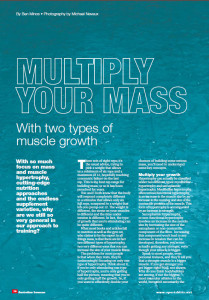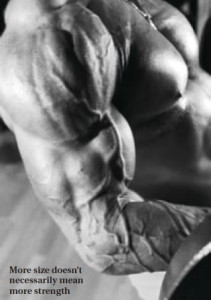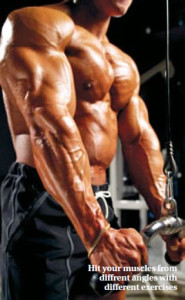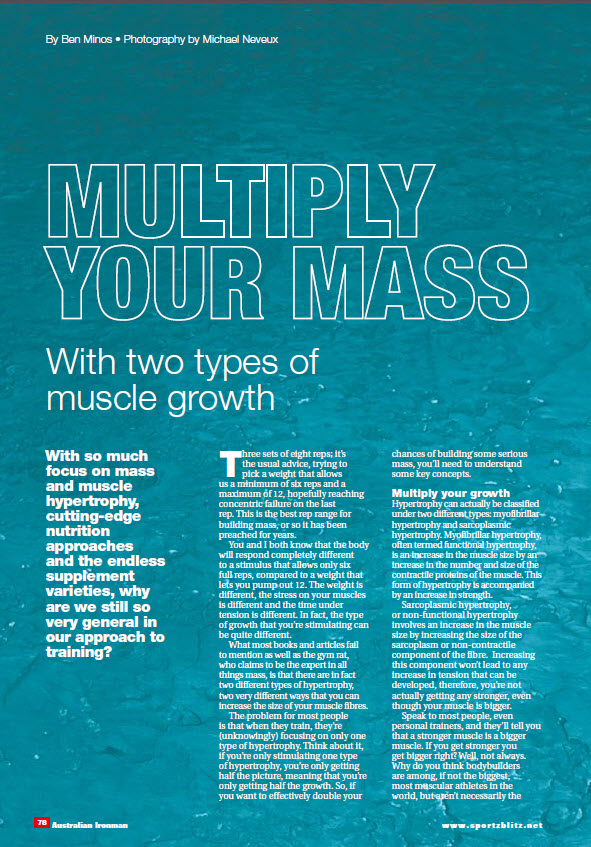Multiply Your Mass With 2 Types of Muscle Growth
(Australian Ironman magazine article by Ben Minos – click here to see PDF of actual article)
With so much focus on mass and muscle hypertrophy, cutting-edge nutrition approaches and the endless supplement varieties, why are we still so very general in our approach to training?

Three sets of eight reps; it’s the usual advice, trying to pick a weight that allows us a minimum of six reps and a maximum of 12, hopefully reaching concentric failure on the last rep. This is the best rep range for building mass, or so it has been preached for years.
You and I both know that the body will respond completely different to a stimulus that allows only six full reps, compared to a weight that lets you pump out 12. The weight is different, the stress on your muscles is different and the time under tension is different. In fact, the type of growth that you’re stimulating can be quite different.
What most books and articles fail to mention as well as the gym rat, who claims to be the expert in all things mass, is that there are in fact two different types of hypertrophy, two very different ways that you can increase the size of your muscle fibres.
The problem for most people is that when they train, they’re (unknowingly) focusing on only one type of hypertrophy. Think about it, if you’re only stimulating one type of hypertrophy, you’re only getting half the picture, meaning that you’re only getting half the growth. So, if you want to effectively double your chances of building some serious mass, you’ll need to understand some key concepts.
Multiply your growth
Hypertrophy can actually be classified under two different types: myofibrillar hypertrophy and sarcoplasmic hypertrophy. Myofibrillar hypertrophy, often termed functional hypertrophy, is an increase in the muscle size by an increase in the number and size of the contractile proteins of the muscle. This form of hypertrophy is accompanied by an increase in strength.
 Sarcoplasmic hypertrophy, or non-functional hypertrophy involves an increase in the muscle size by increasing the size of the sarcoplasm or non-contractile component of the fibre. Increasing this component won’t lead to any increase in tension that can be developed, therefore, you’re not actually getting any stronger, even though your muscle is bigger.
Sarcoplasmic hypertrophy, or non-functional hypertrophy involves an increase in the muscle size by increasing the size of the sarcoplasm or non-contractile component of the fibre. Increasing this component won’t lead to any increase in tension that can be developed, therefore, you’re not actually getting any stronger, even though your muscle is bigger.
Speak to most people, even personal trainers, and they’ll tell you that a stronger muscle is a bigger muscle. If you get stronger you get bigger right? Well, not always. Why do you think bodybuilders are among, if not the biggest, most muscular athletes in the world, but aren’t necessarily the aside, an increase in sarcoplasmic hypertrophy can account for much of this deficit.
So what exactly are these different forms of hypertrophy and how can they be maximised into your training to give you the most developed, muscular physique?
Myofibrillar hypertrophy
Don’t let the name scare you, all this means is that the muscle fibre has increased its size by increasing the density of the myofibrils, the scientific term for the contractile proteins in your muscle.
Your muscle is made up of different substances. The functioning parts of the muscle – the parts that are actually responsible for producing muscle force – are made up of contracting proteins. These parts of the muscle fibre are called myofibrils. If you increase the number and size of myofibrils within the fibre, two things happen. One, you’ve obviously now grown bigger, and two, because the myofibrils are responsible for generating tension in the muscle, the muscle can now generate more force as there are more units to contract. And this of course leads to an increase in strength. So, think of myofibrillar hypertrophy as an increase in muscle size that coincides with an increase in strength.
That is why this form of hypertrophy is often called functional hypertrophy. For this reason, it’s the form of hypertrophy that sports people are most concerned with, as there is no size increase without strength benefits. More specifically, you are not putting on any unnecessary bulk.
It’s important for some athletes to be as light as possible, but also as strong as possible. Neural adaptation aside, this is the most important form of hypertrophy for athletes. It is also a critical form of hypertrophy for bodybuilders as it also increases the density of their muscles. So if you have larger myofibrils and more of them per unit area, you have a denser, harder muscle.
Powerlifters are the perfect example. They are renowned for their dense, thick physiques. They achieve this by lifting heavy, and any form of hypertrophy that occurs is purely functional. They don’t want to get bigger for the sake of it; they want any increase in size to be accompanied by an increase in strength.
Look at the physique of a bodybuilder such as Johnnie Jackson. Johnnie Jackson is infamous for the amazing strength he possesses as a bodybuilder. How did he build this hard dense physique? Through heavy lifting and focusing on the basic compound movements.
The take home message for you is that if you want to build thick, dense, hard, quality muscle, then focus on building myofibrillar hypertrophy. You increase the density of the muscle by increasing the density of the contractile components, and the only way to do this is by lifting heavy and lifting hard. No, we’re not talking about heavy bicep curls. The best way to stimulate functional hypertrophy and strength is to focus on your heavy, basic compound lifts: that is, squats, deadlifts, presses and chins.Now that you know the science of why, never neglect your compounds.
Myofibrillar hypertrophy is best stimulated with heavier weights and lower repetitions, so we’re also not talking about sets of 12-to-15 reps here. Keep the reps lower (four-to-eight) and your sets a little higher (four-to-six) in order to achieve some meaningful strength and size.
Sarcoplasmic hypertrophy
 Sarcoplasmic hypertrophy is completely different. With this form of hypertrophy you can actually increase the size of the muscle fibre without getting any increase in strength.
Sarcoplasmic hypertrophy is completely different. With this form of hypertrophy you can actually increase the size of the muscle fibre without getting any increase in strength.
The sarcoplasm of the muscle is a gooey, fluid filled matrix that occupies the muscle cell and is made up of substances such as intracellular fluid, mitochondria, stored substrates such as carbohydrates and fats, among other things.
For our intents and purposes, just think of the sarcoplasm as the part of the muscle fibre that doesn’t contribute to the force production of a muscle contraction. It’s all the other substances that occupy the muscle cell that don’t directly contribute to force production.
By increasing the amount of sarcoplasm in the muscle you can actually have a bigger muscle without increasing the number of contractile units within the fibre. If the number of contractile units stays the same, but the sarcoplasm increases, the relative density of the muscle actually decreases. You have now actually decreased the muscle cross sectional area, so you are left with a bigger muscle that hasn’t gotten any stronger.
This is why bodybuilders are often chastised for having ‘California muscle’, all show and no go. They possess more size than the average person, but not the absolute strength to match their size. But as we all know, bodybuilders aren’t powerlifters, and the weight you lift doesn’t matter when you’re up on stage posing. As a good friend of mine always says, “no one cares how much you deadlift at the beach”.
Bodybuilders should be praised for discovering how to maximise hypertrophy through all different methods and not just the one-dimensional approach of ‘you must get stronger to get bigger’.
Obviously sarcoplasmic hypertrophy is not ideal for the sportsperson or athlete. Increasing bulk with no gain in strength or performance is not desirable in most sporting endeavours, so if you’re training for athletics, this type of hypertrophy may not be for you.
For the rest of you who are seeking a bigger, more muscular physique, this form of hypertrophy must be maximised along with myofibrillar hypertrophy if you want to sport the most masculine and shapely physique you can.
You can manipulate sarcoplasmic hypertrophy through a number of different methods. Unfortunately, we aren’t able to cover them all here, but using techniques such as drop sets, extended sets and higher rep training, can also have a significant effect on sarcoplasm. One of the better-known examples of transient sarcoplasmic hypertrophy is when you get a really good pump. Blood flow is increased to the muscle, the capillaries fill up with blood, blowing your muscle up like a balloon and forcing some fluid from the blood and extracellular fluid into the muscle fibres. The volume of the sarcoplasm has increased (sarcoplasmic hypertrophy), your muscles are bigger, but aren’t any stronger.
If you want to train effectively for some sarcoplasmic hypertrophy, keep your rep ranges a little higher e.g. around the nine-to-15 mark, even going as high as 20-to-25 on some exercises and muscle groups. Sets may be a little lower to accommodate for the increase in volume.
Along with training techniques, the sarcoplasm can also be influenced by a number of other factors such as nutrition and supplementation.
It is often stated that creatine can dramatically add weight in the initial stages of loading through intracellular fluid retention. So not only does creatine assist in myofibrillar hypertrophy through an increase in strength, it also has a profound effect on sarcoplasmic hypertrophy through increasing the amount of intracellular fluid.
For every gram of carb that your body stores, it also stores three grams of water, so carb loading can often have a profound effect on increasing sarcoplasmic hypertrophy.
Maximising each form of hypertrophy
The most obvious way of maximising each of these is by not getting bogged down into the three sets of eight reps mentality, and experimented with different training techniques, rep ranges, intensities and supplementation.
With the difference between these two types of hypertrophy, you can see that the stimulus required to maximise both varieties will be quite different.
The main guidelines have already been detailed, but just to recap: for myofibrillar hypertrophy you should look to have a good blend of heavy compound exercises with lower rep ranges focused on building functional strength.
To maximise the sarcoplasmic component you should also incorporate a number of other ‘traditional’ bodybuilding techniques such as high rep sets, drop setting, supersetting, and x-reps. Look at various forms of supplementation and keep your nutrition sound and pretty soon you’ll be training just like the pros.
The bottom line is, you can’t expect to train with one type of training technique and demand that it be the ultimate way to stimulate growth. It should be obvious to you now that there is no one best method to stimulate complete growth. If there’s more than one way for your muscle to hypertrophy and get bigger, it’s going to require more than one type of stimulus.
Make sure that you focus on your heavy compounds for each body part, but also back that up with isolation movements, hitting the muscle from different angles and with a variety of bodybuilding exercises and training techniques.
Don’t get me wrong, it’s not as though both of these types of hypertrophy are mutually exclusive, meaning that the two different types don’t happen in total isolation. But you can change the relative focus of the type of hypertrophy you stimulate by changing the relative focus of your workout parameters.
Attack your growth from all possible angles, with as many different training parameters as possible, don’t just slip into a rut of the same routine. The most effective bodybuilding programs are ones that maximise and stimulate all areas of growth, and this is accomplished only through consistently exposing the body to different stimuli and variations in exercises and training techniques.
If you only use one type of training, you’ll only get one type of response. You want maximum muscle and more mass? Then take action, mix up your training, and double your chances of getting huge.
